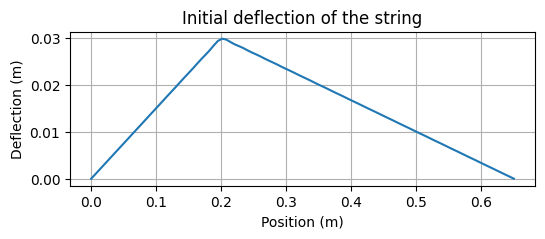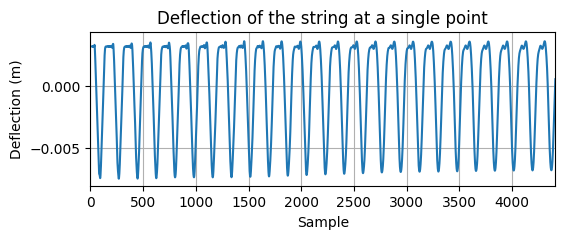For the linear models we want to solve the following equation:
\[\begin{equation}
\rho \ddot{w} + \left(d_1 + d_3 \Delta\right)\dot{w} + (D \Delta \Delta - T_0 \Delta) w = f_{\text{ext}},
\end{equation}\]
which in modal coordinates \(q_{\mu}\) results in uncoupled damped harmonic oscillators:
\[\begin{equation}
\ddot{q}_{\mu} + 2\gamma_{\mu}\dot{q}_{\mu} + \omega_{\mu}^2 q_{\mu} = \bar{f}_{\text{ext},\mu},
\end{equation}\]
where the coefficients are given by:
\[\begin{align}
\omega_{\mu}^2 &= \frac{D\lambda_{\mu}^2 - T_0\lambda_{\mu}}{\rho},\\
\gamma_{\mu} &= \frac{d_1 + d_3\lambda_{\mu}}{2\rho}.
\end{align}\]
String
Some parameters for the string
Code
= 50 = 44100 = 44100 = 1.0 / sample_rate= 0.2 = 0.5 = 0.03 = 101 # number of gridpoints for evaluating the eigenfunctions = StringParameters()
Getting the eigenpairs
Code
= string_eigenvalues(n_modes, string_params.length)= np.sqrt(lambda_mu)= np.linspace(0 , string_params.length, n_gridpoints)= string_eigenfunctions(wn, grid)
Get the initial conditions or the excitation
= create_pluck_modal(= excitation_position,= initial_deflection,= string_params.length,= inverse_STL(K, u0_modal, string_params.length)= plt.subplots(1 , 1 , figsize= (6 , 2 ))"Position (m)" )"Deflection (m)" )"Initial deflection of the string" )True )
Get \(\gamma_{\mu}\) and \(\omega_{\mu}\) and integrate in time from the initial conditions defined above. This should be very fast, even for a large number of modes.
= damping_term(= stiffness_term(= solve_sinusoidal(
Transform the modal solution back to the physical space using the precomputed eigenfunctions, or evaluate at a single point.
= np.arange(1 , n_modes + 1 ) # mode indices = evaluate_string_eigenfunctions(# at a single point = readout_weights @ modal_sol# at all points = inverse_STL(K, modal_sol, string_params.length)
Single point:
Your browser does not support the audio element.
All points:
Plate
We do a very similar thing for plates. First define the parameters
Code
= 8 = 8 = n_modes_x * n_modes_y= 44100 = 44100 = 1.0 / sample_rate= 1.0 # seconds = 1.0 = (0.05 , 0.05 )= (0.1 , 0.1 )= PlateParameters(= 0 ,= 4e-3 ,= 3e-2 ,
Get the eigenpairs
Code
= plate_wavenumbers(= plate_eigenvalues(wnx, wny)= 101 = 151 = np.linspace(0 , plate_params.l1, n_gridpoints_x)= np.linspace(0 , plate_params.l2, n_gridpoints_y)= plate_eigenfunctions(wnx, wny, x, y)# Sort the eigenvalues and get the indices = np.argsort(lambda_mu_2d.ravel())= np.unravel_index(indices, lambda_mu_2d.shape)= ky_indices + 1 , kx_indices + 1 = np.stack([kx_indices, ky_indices], axis=- 1 )= np.sort(lambda_mu_2d.reshape(- 1 ))
This time we will use an excitation force instead on initial conditions. We define the force as a 1D raised cosine at a single point on the plate.
Code
= create_1d_raised_cosine(= excitation_duration,= 0.010 ,= 0.012 ,= excitation_amplitude,= sample_rate,= (= plate_params,/ plate_params.density= evaluate_rectangular_eigenfunctions(= plate_params,= np.outer(rc, weights_at_ex)
Get \(\gamma_{\mu}\) and \(\omega_{\mu}\) and integrate in time using the excitation force.
Code
= damping_term(= stiffness_term(def nl_fn(modal_sol):return 0.0 = solve_tf_excitation(= nl_fn,
Get the solution in physical space
Your browser does not support the audio element.


